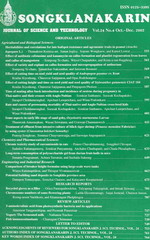ThaiScience
ThaiScience
SONGKLANAKARIN JOURNAL OF SCIENCE & TECHNOLOGY
Volume 42, No. 03, Month MAY, Year 2020, Pages 515 - 520
Altered virulence of non-indole-producing pathogenic bacteria by indole signaling
Paramaporn Rattanaphan, Thunchanok Yaikhan, Pawina Rachniyom, Pimonsri Mittraparp-Arthorn, Varaporn Vuddhakul, Natta Tansila
Abstract Download PDF
Bacteria naturally live in a multispecies community. Cell-to-cell communication is therefore crucial for bacteria to adapt, survive, and regulate virulence. Indole has been recently reported as an intercellular signal that regulates diverse bacterial physiologies such as biofilm formation, antibiotic tolerance, and virulence factor production. The role of indole on bacterial virulence was mainly studied in indole-producing bacteria. Therefore, this study aimed to study the effect of indole on pathogenic non-indole-producing bacteria including Klebsiella pneumoniae, Proteus mirabilis, and Enterobacter cloacae. Bacteria were cultured in a physiological concentration of indole (1 mM), and then growth, biofilm formation, autoaggregation, and motility were evaluated. Indole could increase biofilm formation and autoaggregation of K. pneumoniae, whereas biofilm formation and autoaggregation decreased in E. cloacae and P. mirabilis. Growth of K. pneumoniae and E. cloacae was slightly affected by exposure to indole. This finding indicated that indole influences the virulence of pathogenic non-indole-producing bacteria in different ways. Further studies are still required for a better understanding of the biological functions of indole signaling.
Keywords
indole, biofilm formation, virulence, non-indole-producing bacteria, signaling moleculeSONGKLANAKARIN JOURNAL OF SCIENCE & TECHNOLOGY
Published by : Prince of Songkla University
Contributions welcome at : http://rdo.psu.ac.th
